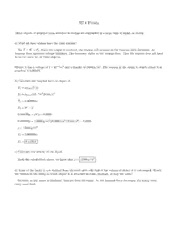
Preview RT4.pdf (PDFy mirror)
RT4 Fluids Three objects of identical mass attached to strings are suspended in a large tank of liquid, as shown. a) Must all three strings have the same tension? No; T =W −F . Since the weight is constant, the tension will increase as the buoyant force decreases. As b buoyant force increases volume increases. The buoyancy varies as the volume does. Thus the tension does not have to be the same for all three objects. Object A has a volume of 1×10−5m3 and a density of 1300kg/m3. The tension in the string to which object A is attached is 0.0098N. b) Calculate the buoyant force on object A. F =ρ (V)g b fluid F =ρ (10−5m3)9.8m/s2 b fluid F =0.000098ρ b F =W −T b 0.000098ρ=ρVg−0.0098 0.000098ρ=(1300kg/m3)(0.00001m3)(9.8m/s2)−0.0098 ρ=1200kg/m3 F =0.000098ρ b F = 0.1176N b c) Calculate the density of the liquid. 3 From the calculations above, we know that ρ= 1200kg/m d) Some of the liquid is now drained from the tank until only half of the volume of object A is submerged. Would the tension in the string to which object A is attached increase, decrease, or stay the same? Increase; as less water is displaced, buoyant force decreases. As the buoyant force decreases, the string must carry more load. An underground fountain carries water to a fountain at ground level. At a point 0.5m below the ground level the pipe has a cross-sectionalarea of 1×10−4m2. At ground level, the pipe has a cross sectional area of 0.5×10−4m2. The water leaves the pipe at a speed of 8.2m/s. a) Calculate the speed of the water IN the pipe. Q is volume flow rate Q=Area(v) −4 2 Q=8.2m/s(10 m ) Q v = area 8.2×10−4m3/s v = 5×10−5m2 v = 4.1m/s b) Calculate the absolute water pressure IN the pipe. 1 1 P + ρv2+ρg△y =P + ρv2+ρg△y 2 2 1 1 P + (1000kg/m3)(4.1m/s)2 =101,000Pa+ (1000kg/m3)(8.2m/s)2+(1000kg/m3)(9.8m/s2)(0.5m) 2 2 P = 131,115Pa abs c) Calculate the maximum height above the ground that the water reaches upon leaving the pipe vertically at ground level, assuming air resistance is negligible, v2 =v2+2g△y o 0m/s=(8.2m/s)2+2(−9.8m/s2)△y (8.2m/s)2 △y = 19.6m/s2 △y = 3.43m d) Calculate the horizontal distance from the pipe that is reached by water exiting the pipe at 60o from the level ground. v =v +at o 0m/s=8.2sin60om/s−9.8m/s2·t 8.2sin60om/s t= 9.8m/s2 t=1.45sec 1.45s(8.2cos60om/s)= 5.94m 2 The large container shown in the cross section is filled with a liquid of density 1.1×103kg/m3. A small hole of area 2.5×10−6m2 is opened in the side of the container a distance h below the liquid surface, which allows a stream of liquid to flow through the hole and into a beaker placed to the right of the container. At the same time, liquid is also added to the container at an appropriate rate so that h remains constant. The amound of liquid collected in the beaker in 2 minutes is 7.2×10−4m3. a) Calculate the volume rate of flow of the liquid from the hole in m3/s. 7.2×10−4m3 = 6×10−6m3/s 120sec b) Calculate the speed of the liquid as it exits from the hole. Q is volume rate of flow Q=Area(v) 6×10−6m3/s=(2.5×10−6m2)(v) v = 2.4m/s c) Calculate the height h of liquid needed above the hole to cause the speed you determined in part (b). 1 1 P + ρv2+ρg△y =P + ρv2+ρg△y 2 2 1 ρg△y = ρv2 2 1 g△y = v2 2 1 (9.8m/s2)(h)= (2.4m/s)2 2 h= 0.29m d) Suppose that there is now less liquid in the container so that the height h is reduced to 1/2 h. In relation to the small cup, where will the liquid hit the countertop? Left Justify your answer. Since there is less liquid in the container, the potential energy of the liquid at h has decreased, and therefore, the speed of the liquid exiting the hole must decrease. This decrease in speed will cause the liquid to land short of the cup, or left of the cup. 3 A diver descends from a salvage ship to the ocean floor at a depth of 35m below the surface. The density of ocean water is 1.025×103kg/m3. a) Calculate the gauge pressure on the diver on the ocean floor. p =p −p gauge absolute atmosphere p =ρgh−101,000Pa gauge p =(1,025kg/m3)(9.8m/s2)(35m)−101,000 gauge p = 351,575Pa gauge b) Calculate the absolute pressure on the diver on the ocean floor. p =p +p absolute gauge atmosphere p −351,575Pa+101,000Pa absolute p = 452,575Pa absolute The diver finds a rectangular aluminum plate having dimensions 1m×2m×0.003m. A hoisting cable is lowered from the ship and the diver connects it to the plate. The density of aluminum is 2.7×103kg/m3. Ignore the effects of viscosity. c) Calculate the tension in the cable if it lifts the plate up at a slow, constant velocity. PF =ma T +F −W =0 b T +F =W b T +ρV g =ρV g water aluminum T +(1m×2m×0.03m)(1000kg/m3)(9.8m/s2)=(2700kg/m3)(1m×2m×0.03m)(9.8m/s2) T = 999.6N d) Will the tension in the hoisting cable increase, decrease, or remain the same if the plate accelerates upward at 0.05m/s2? increase We know that T =W −F if the aluminum is not accelerating. However, when it is accelerating, the equations b becomes T =W −F +ma, so T increases since the right side of the equation increases. b 4
